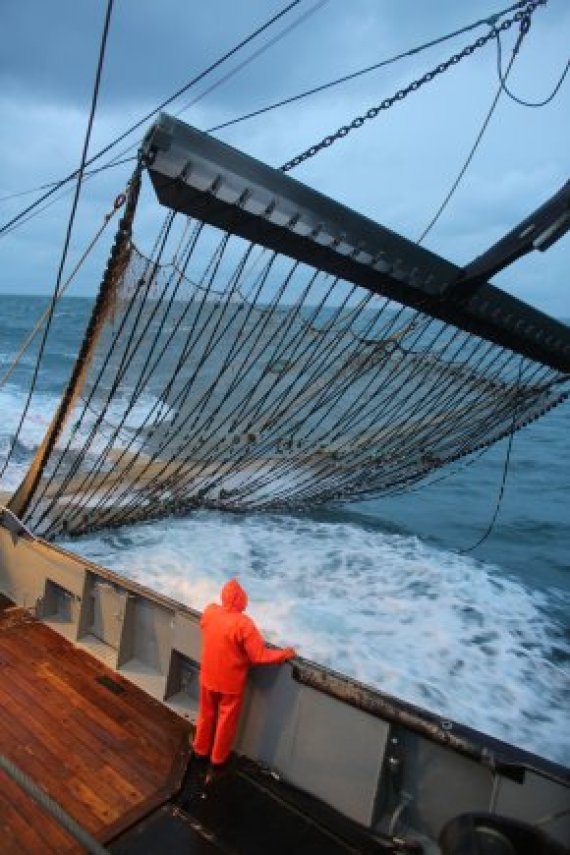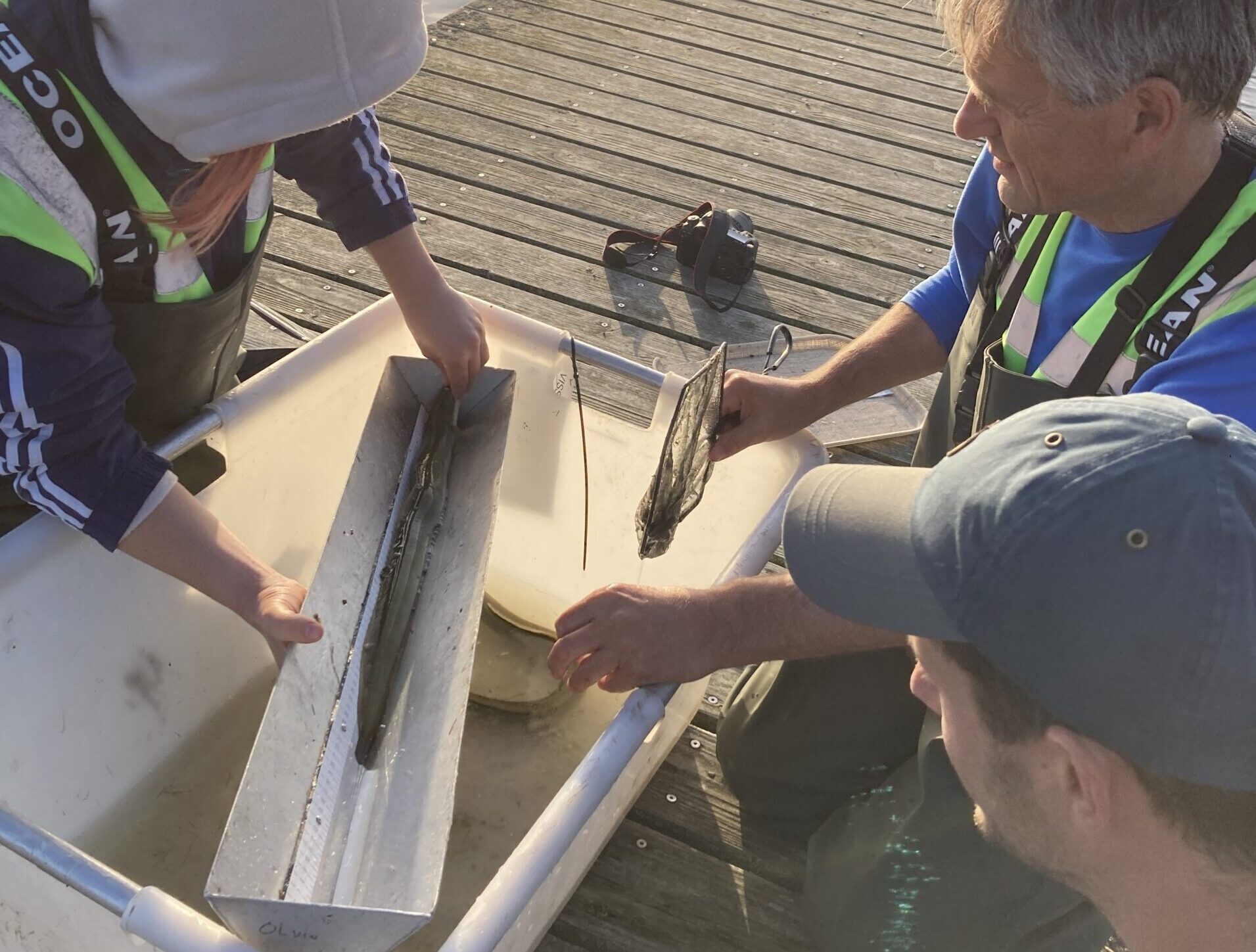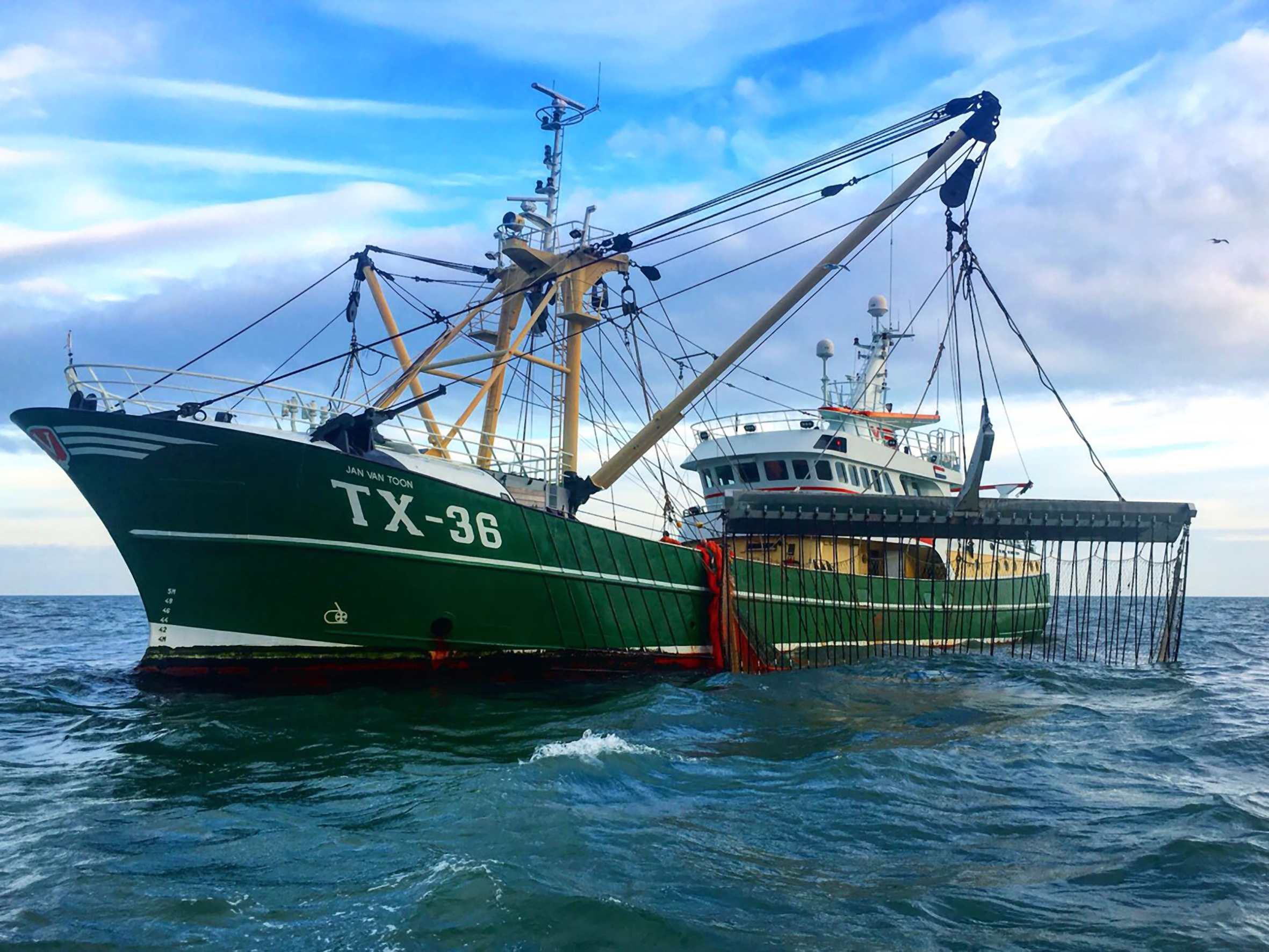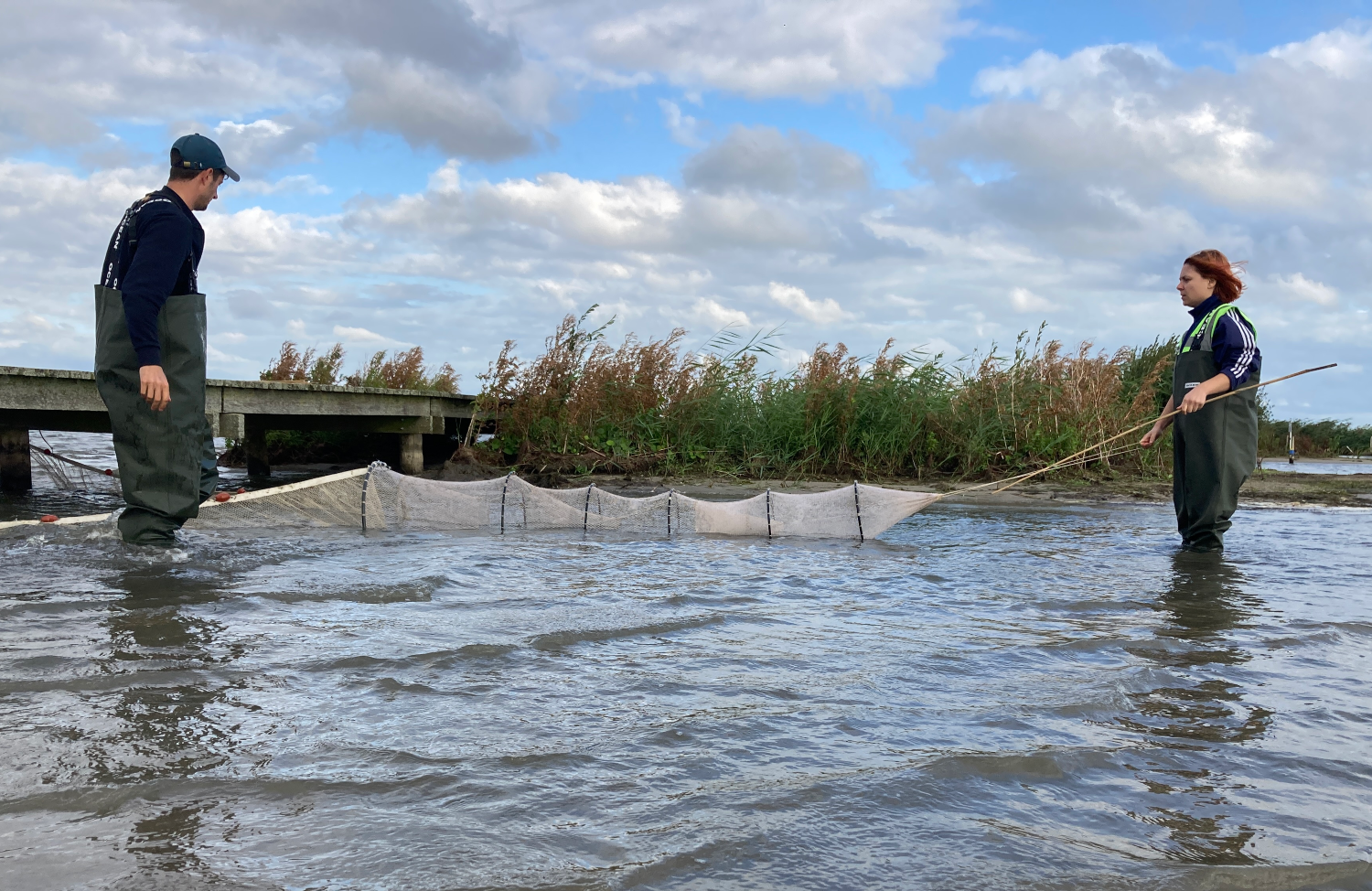Photo: Hollandse Hoogte
Two electrodes suspended in a bucket of water send electrical pulses through the water. It tingles a bit if you put your hand in, but there is no pain. ‘Now it’s at about half strength,’ says Pim Boute, PhD candidate in the Experimental Zoology group at Wageningen University & Research.
Boute is researching the effect of electric pulse trawling on various sea creatures. Pulse trawling is a method that can be used to catch flatfish, for example. Flatfish such as sole and plaice bury themselves in the seabed so they first have to be flushed out before they can be caught in a net. Traditionally, this is done with a beam trawl that drags ‘tickler chains’ across the seabed. These chains plough up the seabed, causing a lot of other creatures to end up in the net as well, including starfish, crabs and shellfish.
Scientists and fishing businesses are looking for more sustainable methods for catching flatfish and are therefore experimenting with pulse trawling. This method involves replacing the tickler chain by electrodes that emit electric pulses — the pulse trawl. Boute: ‘The electric pulses induce brief convulsions in the muscles of the fish, making them to rise up from the seabed and get caught in the net.’
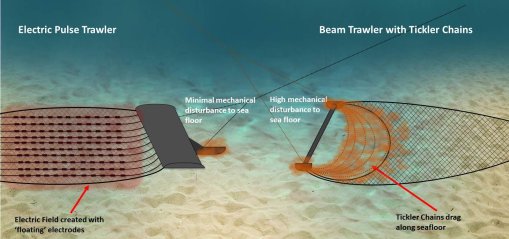
Banned
The pulse trawl does not churn the sea floor up to the same extent, which means fewer creatures living on the seabed end up as bycatch. The ships also use less fuel because the pulse trawl is lighter and has less drag resistance. This means lower CO2 emissions and lower costs for fishermen. The fish that are caught are also better quality on average because they have suffered less damage.
The initial impression is therefore that pulse trawling should be a good alternative to beam trawling. But there is a lot of opposition to the method and it is currently largely banned in Europe (see text box). Since 2009, Member States have been able to obtain an exemption for the southern part of the North Sea for up to five per cent of their fleet. The Netherlands has arranged for 84 such exemptions.
In early 2016, the Dutch Ministry of Economic Affairs commissioned a major research project to investigate the long-term effects of pulse fishing in the North Sea. ‘We want to use that research to predict the effects of large-scale pulse fishing,’ explains project manager Adriaan Rijnsdorp of Wageningen Marine Research. ‘We are expecting this technique to be an improvement, but it’s important to investigate the possible downsides thoroughly so that we can make a well-considered decision.’ The research is being conducted in partnership with the Netherlands Institute for Sea Research (NIOZ) and the Institute for Agricultural and Fisheries Research (ILVO).
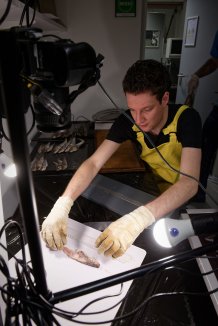
Anaesthetized fish
Pim Boute’s experiments in the Zodiac lab in Wageningen are part of that project. He has created a setup that will let him accurately measure the effects of exposing fish to electric pulses. ‘Some fish are affected by the pulse trawl but not caught in the net, for example, so we can’t examine them on board a fishing boat.’ By simulating the real-life situation in the lab, Boute can still see what the pulses do to the fish.
A tangle of cables connects an aquarium full of electrodes to the computer. The aquarium is about one and a half metres long and wrapped in a thick layer of polystyrene. ‘The fish we are investigating live in the North Sea and it’s colder there,’ explains Boute. ‘We keep the tank cold to stay as close as possible to the natural situation.’ The fish will be anaesthetized first to prevent any distress. Then Boute will measure their muscle activity under different settings for the electrical pulses. At least, if he gets permission from WUR’s Animal Experimentation Board — he is still waiting for that.
In the Zodiac basement, Boute shows us the X-ray room. The stairs down to the basement are concealed behind a zip-up plastic door but even when the zip is closed, you can immediately tell what kind of research goes on here. ‘Sure, we get a few complaints about the stink but we’re working on that,’ says Boute apologetically. X-rays are taken here of fish that have been caught by a pulse trawl. Some photos show breaks in the bones. That is because fish can break their backs if their muscles convulse powerfully. Boute: ‘And that leads to blood in the fillets, which reduces their value. It’s not very animal friendly either. Previous studies showed this happening to cod, for instance, but the results weren’t consistent. That’s why we want to investigate more broadly how often this occurs in commercial catches.’
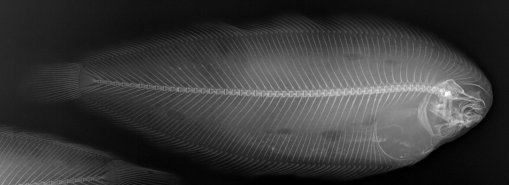
Fishing more selectively
The aim of Boute’s study is to determine the sensitivity of different species of fish and different fish sizes to the pulses. That is because previous research has shown that the effect of the pulses depends on the size and species of fish. Boute: ‘The landing obligation means that fishers now also have to bring back undersized fish and species that are worth less. It might be possible to fish more selectively by choosing the right settings in a way that will let fishermen mainly catch their target fish.’
If the experimental setup works well, Boute will be able to investigate the effect of different pulse settings on different fish species while using relatively few lab animals. He wants to use this data to develop a model that can make predictions for various species of fish.
It might be possible to fish more selectively by choosing the right settings in a way that will let fishermen mainly catch their target fish
He also wants to look at the behavioural effects of pulses on sea creatures that are not being fished. ‘Sharks and rays, for example, can sense electricity. In theory, the pulses could either attract them or repel them, so they could equally well end up in the net. Or not.’ Invertebrates such as beach crabs also react to the electricity. ‘The pulse makes them stiffen. Then they are unable to feed properly and run a greater risk of being eaten. You don’t always see them in the nets but what happens to these creatures could well affect the population and the ecosystem.’
Lugworms
PhD candidate Justin Tiano at NIOZ is also investigating the effects of pulse fishing on the marine ecosystem, and in particular life in the sediment. That is because the electrical field from the pulse trawl permeates the top layers of the seabed.

Tiano does his research in a lab at the other end of the country, in the coastal village of Yerseke in Zeeland. He has a row of glass test tubes with sediment samples about 30 centimetres deep. He took those samples from the seabed using a hollow drill. A tiny tunnel runs through the sand in one of the test tubes. Tiano explains that it was made by a lugworm. ‘It eats sand, then excretes it at the other end as the worm digs deeper. That process mixes up the sediment.’
Lugworms and other creatures on the seabed play an important role in the exchange of nutrients and oxygen between the sea floor and the seawater, explains Tiano. They also help remove nitrogen and phosphate from the water. ‘Too much nitrogen can lead to excessive algal growth, making oxygen levels fall in the water. This then affects the entire ecosystem.’
Tiano is comparing the effects of beam trawl fishing and pulse trawl fishing on the seabed. First, he disturbed his sediment samples to simulate the effect of the chains on the beam trawl. Then he measured the impact this had on the biochemical processes in the sediment. He is currently working on the data analysis. ‘I haven’t got far, but it looks as if disturbing the sediment leads to a temporary increase in the uptake of oxygen by the seabed.’ He plans to carry out another test in which he exposes the sediment samples to electrical pulses to see what happens. That will let him determine which method of fishing is least disruptive for the marine ecosystem.
The future
The researchers don’t spend all their time in the lab. Tiano will soon be going out to sea to take samples in the wake of the pulse trawlers and beam trawlers. He will then compare them with samples from unfished areas. Afterwards, he also wants to investigate the long-term effects of pulse fishing. ‘To do that, we want to use a fishing area where beam trawling is prohibited. Various zones will be designated within that area for fishing with different pulse settings.’
Boute is collecting fish that were caught by commercial boats and assessing the damage. Comparing the results with the outcomes of his lab experiments lets him determine how reliable those experiments are and whether his predictive model is right.
The WUR, NIOZ and ILVO research project is scheduled to run until 2019. The researchers still have a lot of work to do. ‘To have sustainable fishing, it’s important to find out what method and which settings should be used to catch the fish as efficiently as possible, with minimum damage to other creatures and the environment,’ says project manager Adriaan Rijnsdorp. The research results will eventually form part of the scientific basis for a future decision by the EU on pulse fishing.
Tension
The Netherlands has made use of the option of granting up to five percent of its fishers an exemption to the EU ban on electric pulse fishing. Many other EU Member States have not done so and are critical of this method. Earlier this year, the French Minister for the Environment called on the European Commissioner for Fisheries to maintain the ban on electrical stimulation in fishing and revoke the exemptions that have been granted. According to the minister, there are too many ships taking part in pilot projects, not enough is known about the impact and risks, and there is insufficient monitoring. VisNed, the Dutch trawlers’ association, is working on getting pulse trawling accepted in Europe. The organization feels that the opposition is fuelled in part by other countries’ desire to strengthen their competitive position.

